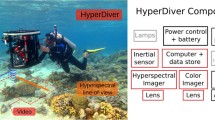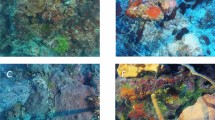Abstract
Loss of marine biodiversity through benthic habitat destruction has created urgent needs for low-cost, high-performance seafloor survey methods. However, accurate seafloor mapping and classification is usually an expensive undertaking requiring sophisticated equipment, which excludes important low-budget user groups in developing nations. In this paper, we introduce a low-cost procedure for seafloor mapping based on free-of-charge data acquisition software that can be downloaded from the Internet. Using a Malaysian coral-reef case-study, we show how comprehensive bathymetric mapping can be implemented with such software using inexpensive eccosounder and GPS, and describe principles for integration of environmental data, either by connecting additional instruments to the computer (up to 32 instruments with up to eight channels each can be handled simultaneously), or by using simple synchronisation techniques with equipment that records to separate media, such as video cameras. We mapped a Malaysian coral-reef area of 114 hectares in 6 hours of video mapping, achieving reef mapping rates that matches rates currently achieved only with air-borne imaging devices. However, the present methodology results in completely ground-truthed data that can be classified according to many schemes by direct observation of the habitat, and provides detailed bathymetric data that satellite imagery or air-borne spectrographic sensors do not provide. The method can be used as a stand-alone reef mapping and classification tool on the scale of tens to hundreds of square kilometres. On larger scales (thousands of square kilometres), airborne survey methods are likely to remain more cost-effective than boat-based methods, yet also in such settings this simple method offer unprecedented capacity for ground truthing and thereby increased capacity for habitat classification.
Similar content being viewed by others
References
Abate, T., 1992. Environmental rapid-assessment programs have appeal and critics. Bioscience 42: 486-489.
Collins, W. T., R. Gregory & J. Anderson, 1996. A digital approach to seafloor classification. Sea Tech. August 1996: 83-87.
De Silva, M. W. R. N., C. Betterton & R. A. Smith, 1984. Coral reef resources of the east coast of peninsular Malaysia. In Chua, T. E. & J. K. Charles (eds), Coastal Resources of East Coast Peninsular Malaysia-an Assessment in Relation to Potential Oil Spills. Universiti Sains Malaysia Press, Penang: 57-90.
English, S., C. Wilkinson & V. Baker, 1994. Survey manual for tropical marine resources. Australian Institute for Marine Science, Townsville, Australia.
Golden Software, 1997. Surfer (Win32) ver. 6.04-Surface mapping system. Golden Software Inc., Golden, Colorado: www.goldensoftware.com.
Gray, J. S., 1997. Marine biodiversity: patterns, threats and conservation needs. Biodiv. Cons. 6: 153-175.
Hamilton, L. J., P. J. Mulhearn & R. Poeckert, 1999. Comparison of RoxAnn and QTC-View acoustic bottom classification system performance for the Cairns area, Great Barrier Reef, Australia. Cont. Shelf. Res. 19: 1577-1597.
Holbrook, S. J., G. E. Forrester & R. J. Schmitt, 2000. Spatial patterns in abundance of a damselfish reflect availability of suitable habitat. Oecologia 122: 109-120.
Johannes, R. E. 1998. The case for data-less marine resource management: examples from tropical nearshore finfisheries. Trends Ecol. Evol. 13: 243-246.
Kloser, R. J., N. J. Bax, R. A. Williams & B. A. Barker, 2001. Remote sensing of seabed types in the Australian South East Fishery; development and application of incident acoustic techniques and associated ‘ground truthing’. Mar. Freshwat. Res. 52: 475-489.
Mumby, P., J. & A. R. Harborne, 1999. Development of a systematic classification scheme of marine habitats to facilitate regional management and mapping of Caribbean coral reefs. Biol. Cons. 88: 155-163.
Mumby, P. J., J. R. M. Chisholm, C. D. Clark, J. D. Hedley & J. Jaubert, 2001. A bird's-eye view of the health of coral reefs. Nature 413: 36.
Roberts, C. M., 1997. Connectivity and management of Caribbean coral reefs. Science 278: 1454-1457.
Sebens, K. P., 1994. Biodiversity of coral reefs: what are we losing and why? Am. Zool. 34: 115-133.
Stoffle, R. W., D. B. Halmo, T. W. Wagner & J. J. Luczkovich, 1994. Reefs From Space-Satellite Imagery, Marine Ecology, and Ethnography In the Dominican-Republic. Hum. Ecol. 22: 355-378.
Tomasick, T., A. J. Mah, A. Nontji & M. K. Moosa, 1997. The Ecology of Indonesian Seas Vol I & II. Dalhousie University, Canada, and Periplus Editions, Hong Kong: 1388 pp.
Wiens, J. A., 1997. Metapopulation dynamics and landscape ecology. In Hanski, I & M. E. Gilpin (eds), Metapopulation Biology. Academic Press, London: 43-62.
Wiens, J. A., N. C. Stenseth, B. Van Horne & R. A. Ims, 1993. Ecological mechanisms and landscape ecology. Oikos 66: 369-380.
Yoccoz, N. G., 1991. Use, over-use and misuse of significance tests in evolutionary biology and ecology. Bull. Ecol. Soc. am. 72: 106-111.
Author information
Authors and Affiliations
Rights and permissions
About this article
Cite this article
Kvernevik, TI., Zambri Mohd Akhir, M. & Studholme, J. A low-cost procedure for automatic seafloor mapping, with particular reference to coral reef conservation in developing nations. Hydrobiologia 474, 67–79 (2002). https://doi.org/10.1023/A:1016508923403
Issue Date:
DOI: https://doi.org/10.1023/A:1016508923403




